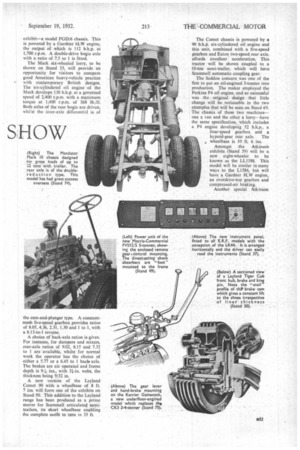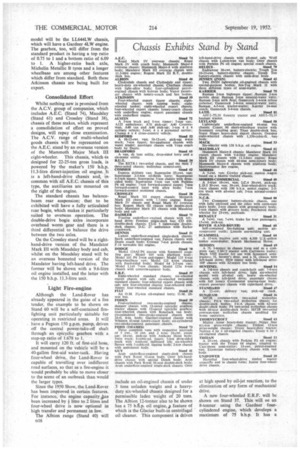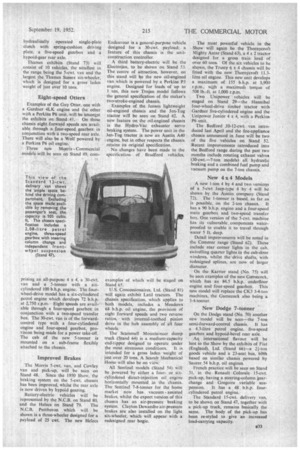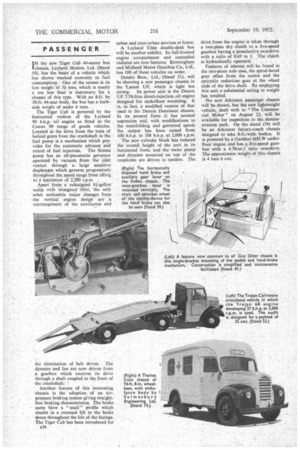VEHICLES TO SEE at the
Page 88

Page 89

Page 90

Page 99

Page 100

Page 101

If you've noticed an error in this article please click here to report it so we can fix it.
SHOW
ALTHOUGH the majority of the models to be shown at Earls Court will be based on chassis which have been in production for some time, a number of surprises has been promised. Some of these will be found in the lighter types of chassis in which the makers are using oil engines, and others in entirely new passenger chassis.
In passenger vehicles the trend is towards substantial reductions in weight and new chassis in which this object has been successfully achieved will be among the highlights of the Show.
On this and following pages, some of the outstanding points of chassis which will be making their public debut at the Show, and of others which have been in production long enough thoroughly to have proved themselves under continuous operating conditions, are described.
ONE of the most interesting features of this year's Show will be the wider application of the oil engine to the lighter types of chassis. An excellent example will be found in the Dennis Stork on Stand 51. This new model, which is styled as a 3-ton delivery van, is powered by a Perkins P4 underfloor four-cylindered oil engine mounted amidships.
The power output of this Perkins unit is 52 b.h.p. at 2,400 r.p.m. To make the fuel-injection pump more
drive to a four-speed crash-type gearbox and thence to a hypoid-gear rear axle. The clutch and accelerator, as well as the two-leading-shoe brakes, have hydraulic control.
The frame design is interesting in that there is a dropped extension at the forward end to provide for a low entrance at the front end of the body. This drop extension, which is 1 ft. 4 ins, high at the cab entrance, carries thc steering box and driving controls.
Since its introduction four years ago, the Foden 4.1-litre six-cylindered twostroke engine has amply justified the confidence placed in it by its sponsors. Its output of 126 b.h.p. almost made history so far as British power units are concerned. Now comes a fourcylinderecl 2.7-litre version developing 84 b.h.p. at 2,000 r.p.m.
This unit will be shown in the Foden F.E. 4/8 8-ton lorry on Stand 39. With the exception of the crankcase, crankshaft, cylinder heads and blower pump, the engine components are similar to those used in the larger unit. It develops its maximum torque of 235 lb.-ft. at 1,500 r.p.m. A conventional forward mounting is adopted, but the design is such that the engine can be withdrawn through the front of the vehicle.
Equally interesting is the nine-speed gearbox on this model. To the rear of a three-speed box is attached a compound epicyelic train of gears giving an overspeed; direct and underspeed range. The main box ' is operated in the normal manner by using the main gear lever and clutch, . '
The auxiliary box has its own lever by means ofywhich a gear may ikp0selected, the change taking place when the load is reversed on the gear teeth. A manual change can be made, by using the clutch pedal.
A 12-speed version of this type of box, operating on the same principle, will be shown in a second Foden exhibit—a model FG13/6 chassis. This is powered by a Gardner 6LW engine, the output of which is 112 b.h.p. at 1,700 r.p.m. A double-drive bogie axle with a ratio of 7.5 to 1 is fitted.
The Mack six-wheeled lorry, to be shown on Stand 33, will provide an opportunity for visitors to compare good American heavy-vehicle practice with contemporary British designs. The six-cylindered oil engine of the Mack develops 130 b.h.p. at a governed speed of 2,400 r.p.m. with a maximum torque at 1,400 r.p.m. of 368 lb./ft. Both axles of the rear bogie are driven, vvhi'st the inter-axle differential is of
the cam-and-plunger type. A constantmesh five-speed gearbox provides ratios of 8.05, 4.36, 2.31, 1.30 and 1 to 1, with a 8.13-to-1 reverse.
A choice of back-axle ratios is given. For instance, for dumpers and mixers, rear-axle ratios of 9.02, 8.15 and 7.32 to 1 are available, whilst for normal work the operator has the choice of either a 5.77 or a 6.45 to 1 back. axle. The brakes are air operated and frame depth is ins., with 31-in, webs, the thickness being 9/32 in.
A new version of the Leyland Comet 90 with a wheelbase of 8 ft. 7 ins, will form one of the exhibits on Stand 50. This addition to the Leyland range has been produced as a prime mover for Scammell articulated semitrailers, its short wheelbase enabling the complete outfit to torn in 35 ft.
The Comet chassis is powered by a 90 b.h.p. six-cylindered oil engine and this unit, combined with a five-speed gearbox and Eaton two-speed rear axle, affords excellent' acceleration. This tractor will be shown coupled to a 10-ton semi-trailer, which will have Scammell automatic coupling gear. The Seddon concern was one of the first to put an oil-engined 3-toriner into production. The maker employed the Perkins P4 oil engine, and so successful was the original design that little change will be noticeable in the two examples that will be seen on Stand 69. The chassis of these two machines— one a van and the other a lorry—have the same specification, which includes a P4 engine developing 52 b.h.p., a
four-speed gearbox and a hypoid-gear rear axle, The , wheelbase is 10 ft. 6 ins. Amongst the Atkinson exhibits (Stand 59) will be a new eight-wheeler to be known as the LL1588. This model will be similar in many ways to the L1586, but will have a Gardner 8LW engine, an overdrive-top gearbox and compressed-air braking.
Another special Atkinson
model will be the LL644LW chassis, which will have a Gardner 4LW engine. The gearbox, too, will differ from the standard product in having a top ratio of 0.75 to I and a bottom ratio of 6.09 to 1. A higher-ratio back axle, Michelin Metallic B tyres and a longer wheelbase are among other features which differ from standard. Both these Atkinson chassis are being built for export.
Consolidated Effort
Whilst nothing new is promised from the A.C.V. group of companies, which includes A.E.C. (Stand 74), Maudslay (Stand 61) and Crossley (Stand 38), chassis of these makes, which represent a consolidation of effort on proved designs, will repay close examination. The A.C.V. range of multi-wheeled goods chassis will be represented on the A.E.C. stand by an overseas version of the Mammoth Major Mark III eight-wheeler. This chassis, which As designed for 22-25-ton gross loads, is powered by the maker's 150 b.h.p. 11.3-litre direct-injection oil engine. it is a left-hand-drive chassis and, incommon with all A.E.C. chassis of this type, the auxiliaries are mounted on the right of the engine.
The standard chassis has balancebeam rear suspension; that to be exhibited will have a fully articulated. rear bogie, which makes it particularly suited to overseas operation. The double-drive bogie axles incorporate overhead worm gear and there is a third differential to balance the drive between the two axles.
On the Crossley stand will be a righthand-drive version of the Mandator Mark III with Maudslay body and cab, whilst on the Maudslay stand will be an overseas bonneted version of the Mandator having left-hand drive. The former will be shown with a 9.6-litre oil engine installed, and the latter with the 150 b.h.p. 11.3-litre unit.
Light Fire-engine
Although the Land-Rover has already appeared in the guise of a fire tender, the example to be shown on Stand 60 will be a self-contained firefighting unit particularly suitable for operating in restricted areas. It will have a Pegson 150 g.p.rn. pump, driven off the central power-take-off shaft through an epicyclic gearbox with a step-up ratio of 1.678 to I.
It will carry 120 ft. of first-aid hose, and mounted on the vehicle will be a 40-gallon first-aid water-tank. Having four-wheel drive„ the Land-Rover is capable of travelling over indifferent road surfaces, so that as a fire-engine it would probably be able to move closer to the scene of an outbreak than would the larger types.
Since the 1950 Show, the Land-Rover has been improved in certain features. For instance, the engine capacity iias been increased by litre to 2 litres and four-wheel drive is now optional in high transfer and permanent in low.
The Albion range (Stand 40) will include an oil-engined chassis of under 3 tons unladen weight and a heavyduty six-wheeled chassis designed for a permissible laden weight of 20 tons. The Albion 12-tonner also to be shown has a 75 bin. oil engine, feature of which is the Glacier built-in centrifugal oil cleaner. This component is driven at high speed by oil-jet reaction, to the elimination of any form of mechanical drive.
A new four-wheeled E.R.F. will be shown on Stand 37. This will De an 8-tonner using the Gardner f ourcylindered engine, which develops a Maximum of 75 b.h.p. It has a
hydraulically operated single-plate clutch with spring-cushion driving plate, a five-speed gearbox and a hypoid-gear rear axle.
Thames exhibits (Stand 73) will consist of 10 vehicles, the smallest in the range being the 5-cwt. van and the largest the Thames Sussex six-wheeler, which is designed for a gross laden weight of just over 10 tons.
Bight-speed Otters
Examples of the Guy Otter, one with a Gardner 4LK engine and the other with a Perkins P6 unit, will be amongst
the exhibits on Stand 41, On these chassis eight forward speeds are available through a four-speed. gearbox, in conjunction wi th•a two-speed rear axle. There will also be a Wolf powered by a Perkins P6 oil engine.
' Three new Morris Commercial models will be seen oil Stand 49, coin prising an all-purpose 4 x 4, a 30-cwt. van and a 5-tonncr with a sixcylindered 100 b.h.p. engine. The fourwheel-drive model has a six-cylindered petrol engine which develops 72 b.h.p. at 2,750 r.p.m. Eight speeds are available through a four-speed gearbox in conjunction with a two-speed transfer box, The 30-cwt. van is of the forwardcontrol type with a four-cylindered engine and four-speed gearbox, provision being made for a power take-off. The cab of the new 5-tonner is mounted on a sub-frame flexibly attached to the chassis.
Improved Brakes
The Morris 5-cwt. van, and Cowley van and pick-up, will be seen on Stand 48. Since the 1950 Show, the braking system on the 5-cwt. chassis has been improved, whilst the rear axle is now driven by hypoid gearing.
Battery-electric vehicles will be represented by the N.C.B. on Stand 80, and the Helecs on Stand 79. The N.C.B. Pereheron which will be shown is a three-wheeler designed for a payload of 25 cwt. The new Helecs Endeavour is a general-purpose vehicle designed for a 30-cwt, payload; a feature of this chassis is the unitconstruction controller.
A third battery-electric will be the Electrojan, to be shown on Stand 53. The centre of attraction, however, on this stand will be the new oil-engined van which is powered by a Perkins P3 engine. Designed for loads of up to 1 ton, this new Trojan model follows the general specification of the maker's two-stroke-engined chassis.
Examples of the Jensen lightweight oil-engined chassis and the Jcn-Tug tractor will be seen on Stand 42. A new feature on the oil-engined chassis is the Hydro-Vac exhauster servo . braking system. The power unit in the Jen-Tug tractor is now an Austin. A40 engine, but in other respects the chassis retains its original specification.
No changes have been made in the specification of Bradford vehicles, examples of which will be staged on Stand 65.
U.S. Concessionaires, Ltd. (Stand 81) will again exhibit Latil tractors. The chassis specification, which applies to both models, includes a Meadows 68 b.h.p. oil engine, the provision of eight forward speeds and two reverse ratios, with internal-toothed pinion drive in the hub assembly of all four wheels.
The Scammell Mountaineer dump truck .(Stand 64) is a medium-capacity end-tipper designed to operate under the most strenuous conditions. It is intended for a gross laden weight of just over 20 tons. A Scarab Mechanical Horse will also be on view.
All Sentinel models (Stand 54) will be powered by either a fouror sixcylindered direct-injection oil engine_ horizontally mounted in the chassis. The Sentinel 7-8-tonner for the home market now has vacuum assisted brakes, whilst the export version of this chassis has an air-pressure braking system. Clayton L)cwandre air-pressure brakes are also installed on the light six-wheeler, which will appear with a redesigned rear bogie. • The most powerful vehicle in the Show will again be the Thornycroft Mighty Antar (Stand 63), a 4 x 2 tractor designed for a gross train load of over 60 tons. Of the six vehicles to be shown, the Trusty 6 x 4 chassis will be fitted with the new Thornycroft 11.3litre oil engine. This new unit develops a maximum of 155 b.h.p. at 1,900 r.p.m., wijh a maximuiii torque of 508 lb.-ft, at 1,000 r.p.m.
Two Unipower vehicles will be staged on Stand 29—the Hannibal four-wheel-drive timber tractor with Gardner five-cylindcred engine and the Unipower Junior 4 x 4, with a Perkins P6 unit.
The Bedford ,10-12-cwt: van introduced last April and the fire-appliance chassis announced in June will be two of the five vehicles on Stand 52. Recent improvements introduced into the Bedford range during the past two months include rotating exhaust valves (30-cw(.-7-ton models) all hydraulic braking and a combined fuel pump and vacuum pump on the 7-ton chassis.
New 4 x 4 Models A new l-ton 4 by 4 and two versions of a 5-cwt Jeep-type 4 by 4 will be shown by the Austin company (Stand 72). The 1-tonner is based, as far as
is possible, on the 2-ton chassis. It has a 90 b.h.p. engine and a four-speed main gearbox and two-speed transfer box. One version of the 5-cwt. machine has its vulnerable, components waterproofed to enable it to travel through water 5 ft. deep.
Detail improvements will be noted in the Commer range (Stand 62). These include rear corner lights in the cab, swivelling quarter lights in the cab-door v6ndows, whilst the drive shafts, with redesigned splines, are now of Larger diameter.
On the Karrier stand (No. 75) will be seen examples of. the new Gamecock, which has an 84.5 b.h.p. underfloor engine and four-speed gearbox. This new model will replace the CK3 3-4-ton machines, the Gamecock also being a 3-4-tonner.
New Dodge 7-tonner On the Dodge stand (No. 70) another new model will be seen—the 7-ton
semi-forward-control chassis. It has a 4.3-litre petrol engine, five-speed gearbox and hypoid-bevel rear axle.
At international flavour will be lent to the Show by the exhibits of Fiat (England), Ltd. (Stand 66)—a 2}-ton goods vehicle and a 23-seat bus, Rah based on similar chassis powered by Saurer 54 b.h.p. oil engines.
French practice will be seen on Stand 31, in the Renault Colorale 15-cwt. pick-up, having a steering-column gearchange and Gregoire variable suspension. it has a 48 b.h.p. four. cylindered petrol engine.
The Standard 15-cwt, delivery van, to be shown on Stand 47, together with a pick-up truck, remains basically the same. The body of the pick-up has been re-styled to • give an increased load-carrying capacity.
PASSENGER
I N the new Tiger Cub 44-seater bus chassis, Leyland Motors, Ltd. (Stand 50), has the basis of a vehicle which has shown marked economy in fuel consumption. One of the causes is its
low weight of tons, which is nearly a ton less than is Customary for a chassis of this type. With an 8-ft. by 30-ft. 44-seat body, the bus has a kerbside weight of under 6 tons.
The Tiger Cub is powered by the horizontal vedion of the Leyland 90 b.h.p. oil engine as fitted in. the Comet 90 range of goods vehicles. Located in the drive from the train of helical gears from the crankshaft to the fuel pump is a mechanism which provides for the automatic advance and retard of fuel injection. The Simms pump has an all-pneumatic governor operated by vacuum from the inlet venturi through a-, large sensitive diaphragm which governs .progressively throughout the speed range from idling to a maximum of 2,200 r.p.m„ Apart from a redesigned -41-gallon sun-1p with 'elongated filler, the only other noticeable major changes from the vertical engine design are a rearrangement of the auxiliaries and the elimination of belt drives. The dynamo and fan are now driven from a gearbox which receives its drive through a shaft coupled to the front of the crankshaft.
Another feature of this interesting chassis is the adoption of an airpressure braking system giving straightline braking characteristics. The brake cams have a "snail" profile which results in a constant lift to the brake shoes throughout the life of the facings. The Tiger Cub has been introduced for B34 urban and inter-urban services at home.
A Leyland Titan double-deck bus will be another exhibit. Its full-fronted engine compartment and concealed radiator arc new features. Birmingham and Midland Motor Omnibus Co., Ltd., has 100 of these vehicles on order.
Dennis Bros.,. Ltd. (Stand 51), will be showing a new passenger chassis in the 'Lancet UF, which is light but strong. Its power unit is the Dennis UF 7.58-litre direct-injection oil engine designed for underfloor mounting. It is, in fact, a modified version of that used in the Dennis Dominant chassis. In its present form it has normal aspiration and, with modifications to the manifolding and governed speed, the output has been raised from 100 .b.h.p. to 108 b.h.p. at 2,000 r.p.m.
The new cylinder block has reduced the overall height of the unit in its horizontal form, and the water pump and dynamo mounted on top of the crankcase are driven in tandem. The
drive from the engine is taken through a two-plate dry clutch to a five-speed gearbox having a preselective overdrive with a ratio of 0.69 to 1. The clutch is hydraulically operated.
Features of interest will be found in the two-piece axle case, the spiral-bevel gear offset from the centre and the epicyclic reduction gear at the wheel ends of the drive shaft. By employing this unit a substantial saving in weight has resulted.
No new Atkinson passenger chassis will be shown, but the new lightweight vehicle,, dealt with in "The Commercial Motor" on August 22, will be available for inspection in the demonstration park. On the stand (59) will be an Atkinson luxury-coach chassis designed to take 8-ft.-wide bodies. It is powered by a Gardner 6HLW underfloor engine and has a five-speed gearbox with a 4.78-to-1 ratio overdrive. The approximate weight of this chassis is 4 tons 6 cwt.
In a new Seddon chassis to be shown (Stand 69), a Perkins vertical engine is mounted amidships.
In a new double-deck chassis to be displayed by the Daimler concern (Stand 71), a saving in weight of 10 cwt. has been achieved, as compared with the normal 54-56-seater bus chassis (see pages 208-209).
Both the vehicles to be displayed by Albion (Stand 40) will be based on the Victor 16-IL-wheelbase chassis, which has a 75 b,h.p. oil engine and fivespeed constant-mesh gearbox. Both will be seen with 31-scat bodies.
Two makes of trolleybus will be represented in the B.U.T. and the Sunbeam. B.U.T. (Stand 30) will have a two-axled and a three-axled chassis. Originally designed for export, the twoaxled model will be seen with its frame reduced to conform to the maximum legal length for use at home. Its width remains at 8 ft. A similar modification has been carried out to the Sunbeam MF2B trolleybus chassis originally designed for export. This chassis, with a wheelbase of 15 ft. 6 ins., was designed for a 54-seat double-deck body having an entrance forward of the front axle and a central exit.
A Thames 2-ton chassis with a fourstretcher ambulance body will be shown on Stand 73. A feature of the body is that it is framed and panelled throughout with aluminium.
One of the Guy chassis on Stand 4l will be of a type to be supplied to London Transport. It is powered by a Perkins P6 oil engine, Other items in the specification include a single-speed rear axle having a ratio of 5.7 to I. Ciirling two-leading-shoe brakes and 7.50 by 20-in. tyres. The new Sentinel right-hand-drive export chassis (Stand 54) has been designed for 8-ft.-wide bodies. Powered by a Sentinel six-cylindered oil engine developing a maximum of 120 b.h.p., it has an independently mounted fivespeed gearbox. The rear axle is of the overhead-worm type and the brakes are operated on the Clayton Dewandre
air-pressure system. It has a wheelbase of 18 ft. 4 ins, and weighs 51 tons.
An A.E.C. Regal Mark IV w ill be shown both as a chassis and as a complete coach on Stand 74. The 9.6-litre oil engine is fitted in this chassis, which has a preselective gearbox and hydraulic coupling. A second complete vehicle will be a Regent Mark 111 R.T.-type double-deck bus as supplied to London Transport.
On Stand 38 the Crossley member of the A.C.V. group will stage a left-handdrive version of the Regal Mark III and a right-hand-drive version of the Real Mark IV, both having 9.6-litre oil engines.
The Maudslay concern will have, on Stand 61, two complete vehicles in the form of a Regal Mark IV fitted with a 44-seat semi-luxury body and a Merryweather fire-engine with a Park Royal body.. The fire-engine will be fitted with a 9.6-litre oil engine and a slidingmesh four-speed gearbox.
Two Foden passenger chassis will be found in models PVRG6 and PVRE6 (Stand 39). The former will be shown as a complete vehicle with a Whitson 44-seat luxury body. This model has the Gardner 6LW 120 b.h.p. engine. whilst the PVRF has the rear-mounted Foden two-stroke unit which develops a maximum of 126 b.h.p. The Gardner-engined chassis has a fourspeed gearbox and the " two-stroke " a five-speed gearbox.
There will be a Vega 35-seat 8-ft.wide coach with Duple bodywork on Stand 52, to be occupied by Vauxhall Motors, Ltd.
The Ranier 14-seat coach, to be shown on Stand 75, is a forward-control model having a special system of suspension employing low-pressure tyres, direct-acting shock absorbers and long. soft springs. Another vehicle of this type will be found in—the bodywork section.




































































































































































